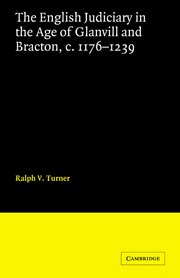Book contents
- Frontmatter
- Contents
- Acknowledgements
- Abbreviations
- 1 THE REPUTATION OF THE ROYAL JUSTICES
- 2 GLANVILL AND HIS COLLEAGUES, c. 1176–89
- 3 THE ORIGINS OF A PROFESSIONAL JUDICIARY IN THE REIGN OF RICHARD I
- 4 KING JOHN'S CORPS OF JUSTICES
- 5 PATTISHALL, RALEIGH AND THEIR COLLEAGUES
- 6 THE WORK OF THE JUSTICES
- Conclusion: The judges and their critics
- Appendix: Royal justices, c. 1176–1239
- Manuscript sources
- Index
- CAMBRIDGE STUDIES IN ENGLISH LEGAL HISTORY
5 - PATTISHALL, RALEIGH AND THEIR COLLEAGUES
Published online by Cambridge University Press: 07 October 2011
- Frontmatter
- Contents
- Acknowledgements
- Abbreviations
- 1 THE REPUTATION OF THE ROYAL JUSTICES
- 2 GLANVILL AND HIS COLLEAGUES, c. 1176–89
- 3 THE ORIGINS OF A PROFESSIONAL JUDICIARY IN THE REIGN OF RICHARD I
- 4 KING JOHN'S CORPS OF JUSTICES
- 5 PATTISHALL, RALEIGH AND THEIR COLLEAGUES
- 6 THE WORK OF THE JUSTICES
- Conclusion: The judges and their critics
- Appendix: Royal justices, c. 1176–1239
- Manuscript sources
- Index
- CAMBRIDGE STUDIES IN ENGLISH LEGAL HISTORY
Summary
THE JUDICIAL BENCH IN EARLY HENRY III, 1217–39
The machinery of normal government came to a standstill during the baronial rebellion that broke out at the end of John's reign, and royal justices only resumed their work in the fall of 1217 or in early 1218. The justiciar Hubert de Burgh took a number of assizes in Norfolk and Suffolk in the summer of 1218. The promise made in Magna Carta that common pleas ‘shall be heard in some fixed place’ (cap. 17) demanded that the minority council turn its attention to reopening a court at Westminster as soon as possible. Apparently William Marshal and others in the ruling council heard pleas at Westminster in Michaelmas term 1217, and a regular court of Common Pleas was functioning throughout 1218, although no plea rolls survive before Trinity 1219. The accession of Henry III, a boy of nine, marked a return to conditions that had prevailed before the loss of Normandy. Just as the king's absence then precluded a court coram rege, so now the king's minority meant that again the Bench at Westminster would be the only central common law court. James of Potterne, one of the small band of coram rege justices in King John's last years, received a command in 1218 to turn over to a royal clerk estreats and writs in his possession from the previous reign.
- Type
- Chapter
- Information
- Publisher: Cambridge University PressPrint publication year: 1985
- 1
- Cited by



